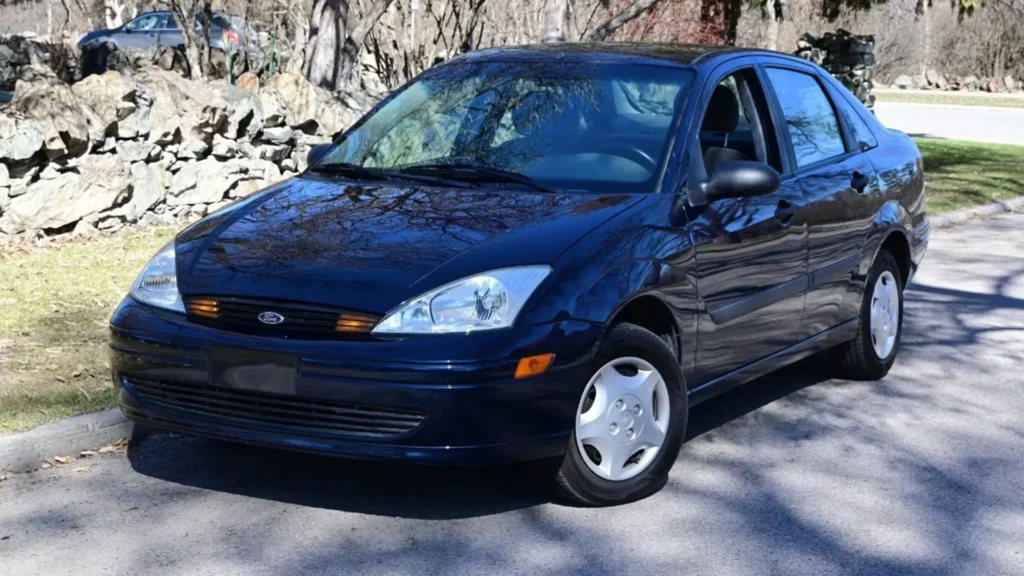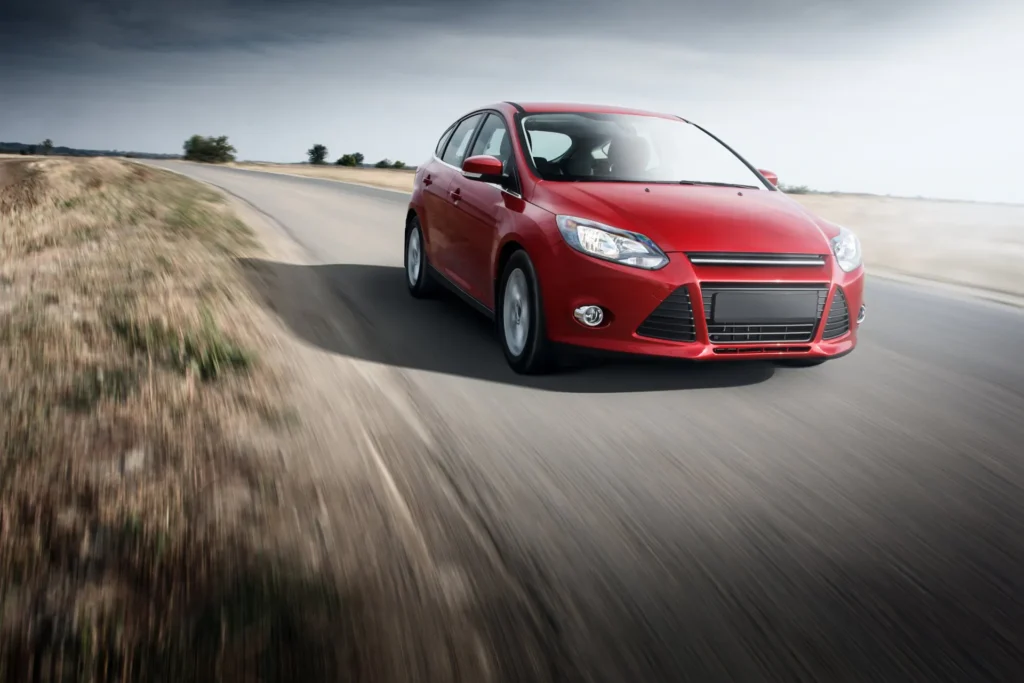It will be our pleasure to assist you in selecting the best model year for your Ford Focus. Over the years, we’ve spent countless hours categorizing which Ford Focus years are best avoided and which ones are best to purchase.
The ultimate Ford Focus guide includes a comprehensive breakdown, highlighting the best and worst years of the car over its various generations.
We’ve meticulously compiled insights from authoritative sources like KBB, NHTSA, and others highlighting the acclaim and criticism that have been associated with this popular vehicle.

In this guide, we’ll explain everything you need to know about the Ford Focus lineage, whether you’re a potential buyer, an enthusiast, or just curious.
Let’s get started.
Ford Focus Generations
In the compact car segment, the Ford Focus has changed everything.
Introducing the first generation Focus in 2000, it quickly became a favorite among urban drivers and car enthusiasts due to its innovative design, advanced safety features, and responsive handling.
Below, we’ve listed Ford Focus generations for those interested in pre-owned Focuses or simply looking to understand its evolution:
| Generation | Years |
| 1st generation (MK1) | 2000-2007 |
| 2nd generation (MK2) | 2008-2011 |
| 3rd generation (MK3) | 2012-2018 |
It is vital for potential Ford Focus buyers to understand the differences between the generations. The performance, design, and technology of most vehicles change significantly with every generation.
Ford Focus Best, Neutral and Worst Years
A broad range of factors are taken into account in our analysis and categorization of the Ford Focus best and worst years, including but not limited to:
In accordance with the graphical analysis, we have created a table that categorizes Ford Focus model years into three categories: optimal, neutral, and worst.
| Generation | Best Years | Neutral Years | Worst Years |
| 1st generation (MK1) | 2004 2005 2006 2007 | N/A | 2000 2001 2002 2003 |
| 2nd generation (MK2) | 2008 2009 2011 | N/A | 2010 |
| 3rd generation (MK3) | 2017 2018 | 2015 2016 | 2012 2013 2014 |
Due to its availability in North America, we did not include the 4th generation Ford Focus.
There are times when the Ford Focus does not stand out as one of the best or worst vehicles in its class. The performance, reliability, and customer satisfaction of these models are generally average, with a balance between reported issues and positive feedback.
These rankings can be adversely affected by certain factors, especially NHTSA recalls. Recalls and complaints indicate lower reliability for a particular year when there are a higher number of them.
The specification of the best, fairest, and worst years will help us understand their strengths and weaknesses.
Best & Worst Years for Ford Focus 1st Generation (2000-2007)
In 2000, Ford Focus introduced a new era for compact cars, combining innovative technology with modern styling. This generation of the Focus witnessed significant changes during its lifecycle from 2000 to 2007.

The Best Years: 2004, 2005, 2006, 2007
In 2004, Ford overhauled the Ford Focus in significant ways. As a result of its reliable performance and reliability, the Duratec 20 2.0L DOHC I-4 engine became a popular choice.
It was also during this period that the PZEV engine, which is more eco-friendly, was introduced. Various transmission options ensured a versatile driving experience, including a dependable manual transmission or an automatic transmission.
This period was marked by Ford’s introduction of the basic S, the intermediate SE, and the premium SES trim levels. A zestier drive was available in the ST version for those who preferred a sportier drive.
In order to keep up with the latest technology, Ford incorporated MP3 CD players and improved connectivity solutions into its audio systems.
A reinforced chassis structure, advanced airbags, and enhanced braking mechanisms were all part of Ford’s safety upgrade of the Focus, which redefined safety standards.
The Worst Years: 2000, 2001, 2002, 2003
There were challenges involved in the launch of the Ford Focus. In particular, there was a great deal of controversy between 2000 and 2003.
A staggering 3880 complaints were filed against the 2000 model in NHTSA, and 18 recalls were issued. There were many complaints regarding the electrical system, with a third highlighting it as a major issue.
In addition, suspension, brakes, and transmission problems were reported, followed by engine blazes. As a result of battery cables and wire harnesses that could cause fire, Ford issued two recalls impacting as many as 290000 vehicles.
In 2001, the successor attempted to carry on the torch, but engine stalling was one of its notable problems. There were 671,000 Ford vehicles recalled in 2003 due to contamination in their Fuel Delivery Modules.
A second recall was issued for 446569 Ford Focus 2000-2001 models regarding steering pinch bolts that may become loose, leading to ball joint stud fractures.
If you’re considering buying an early model of the Focus, be sure to check the VIN and do some in-depth research.
Recalls and issues related to Ford Focus in 2000, 2001, 2002, and 2003 can be found on the NHTSA website.
Best & Worst Years for Ford Focus 2nd Generation (2008-2011)
Taking advantage of the success of the previous generation, Ford introduced the second generation of the Ford Focus in 2008. Among all generations of the Ford Focus, this generation received the highest Kelley Blue Book rating of 4.6.

According to Edmunds, J.D Power, Vehicle History and Cars.com, it is the highest-ranked Ford Focus generation.
The Best Years: 2008, 2009, 2011
A new generation of the Ford Focus was introduced in 2008 with a renewed sense of vigor. Further refinements were made to Ford’s engine line-up, with the established Duratec engine series being largely used, optimizing them for better fuel economy and smoother performance.
Most trims were equipped with the 2.0L inline-four engine, which improved performance from 136 hp to 140 hp, as well as fuel efficiency up to 20 mpg in the city and 37 mpg on the highway.
In addition to the five-speed manual transmission, a more refined four-speed automatic transmission is available for drivers who prefer a relaxed drive experience.
As far as trim levels are concerned, Ford offered a wider range of options for consumers. It’s true that Ford’s base model, the S, is well equipped for its category, but it’s in the SE and SES variants where the company truly excels.
As a result, these trims included features such as SYNC voice-activated systems, more connected and entertainment features, and an improved driving experience.
Also by 2011, Ford had included advanced safety features, such as Electronic Stability Control and a tire pressure monitoring system, which ensured safety standards were not only met but exceeded.
The Worst Years: 2010
It was a challenging year for Focus in 2010, despite the advancements and accolades.
Although no recalls for that model year were registered with the NHTSA, some owners reported electrical malfunctions, engine hitches, and minor transmission issues.
Consumer Reports rated the model with a respectable 18 miles per gallon in the city and 35 miles per gallon on the highway, although it was only a slight improvement over its predecessor.
It is noteworthy that despite these challenges, the 2010 year did not come with significant pitfalls, but rather some nuances that confused consumers.
Best & Worst Years for Ford Focus 3rd Generation (2012-2018)
The Ford Focus, now in its third generation, saw a significant design shift in 2012, featuring more modern features that cater to a generation that emphasizes tech integration and efficiency.

There were also highs and lows with this generation, from the epitome of design and efficiency to the concerns about transmissions and engines.
The Best Years: 2017, 2018
A zenith of Ford’s efforts to make the quintessential compact car was reached during the latter part of the third generation, specifically in the years 2017 and 2018.
It was during these years that Ford improved many of the issues that plagued earlier models of the Focus. With more refined engine options, fuel efficiency was improved and power was delivered more efficiently.
As a result of the adoption of EcoBoost technology in 2017 and 2018, performance enhancements were made without sacrificing efficiency.
For city driving, Consumer Reports rate the vehicle at 19 mpg, and for highway cruising, it is rated at 43 mpg.
Despite the diversity of trim levels, there was something for almost everyone, from basic commuters to tech-savvy drivers. A special feature of the Titanium and ST trims was the advanced technological integration they featured.
With advances such as Adaptive Cruise Control, Lane-Keeping System, and the upgraded SYNC 3 infotainment system, the vehicle was more connected and safer while driving.
The addition of Active Park Assist also demonstrates Ford’s commitment to safety. Cities and parking will be considerably easier with Active Park Assist.
The Neutral Years: 2015, 2016
With the 2015 and 2016 Focus models, we managed to rectify the previous errors made with the early 3rd generation models.
There were still transmission issues in these years, even though NHTSA complaints decreased. The majority of Focus owners were satisfied with Ford’s response, but some segments remained dissatisfied.
In spite of transmission concerns, these years are neutral in terms of overall performance and reliability due to upgraded technology and enhanced safety features.
The ability of Ford to constantly improve was evident, laying the groundwork for the subsequent heyday of this generation.
The Worst Years: 2012, 2013, 2014
The onset of the third generation was ambitious but faced a set of challenges that somewhat tainted its reputation.
In particular, transmission problems were the primary cause of the problem. There have been many reports of owners experiencing unexpected transmission overheats, which could pose a safety risk.
A significant issue was the loss of power steering assistance, a complaint that Ford didn’t address with a recall despite numerous complaints.
A recurring problem was engine stalling, leading Ford to issue a number of recalls to address both transmission and engine stalling.
This generation was rated at a slightly disappointing 3.7 out of 5 by Kelley Blue Book due to these concerns.
Recalls and complaints regarding Ford Focus from 2012, 2013, 2014 are available from the NHTSA website.
Best & Worst Ford Ranger Years | Years To Avoid
Best & Worst Ford F-150 Years | Years To Avoid
Best & Worst Ford Explorer Years | Years To Avoid
Best & Worst Ford Escape Years | Years To Avoid
Ford Focus Says Transmission Fault Service Now
Best & Worst Ford Fusion Years | Years To Avoid
Best & Worst Ford Expedition Years | Years To Avoid
Best & Worst Ford F-250 Years | Years To Avoid
Conclusion
Following Ford Focus’s journey over the years, it’s pretty clear that determining an informed purchase decision means understanding each generation’s strengths and weaknesses.
Have you personally experienced the Ford Focus model year, and how does it compare to ours?
In the comments section, tell us about your own Ford Focus experience.
